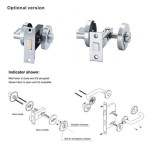Miniature Bathroom Sinks: Maximizing Space and Efficiency
The miniature bathroom sink, also frequently called a small bathroom sink or compact sink, represents a significant trend in modern bathroom design. Driven by the increasing need to adapt to smaller living spaces, optimize existing bathroom layouts, and enhance design aesthetics, these sinks offer versatile solutions for a wide range of applications. Understanding their functionality, diverse styles, and installation considerations is crucial for homeowners, designers, and contractors seeking to maximize space and efficiency without compromising on style and practicality.
This article explores the world of miniature bathroom sinks, detailing their benefits, the variety of available options, and the key factors to consider during selection and installation. By understanding these aspects, individuals can make informed decisions to create functional and visually appealing bathroom environments.
Benefits of Installing a Miniature Bathroom Sink
The primary advantage of a miniature bathroom sink lies in its space-saving capabilities. In powder rooms, guest bathrooms, or en-suite bathrooms with limited square footage, a full-sized sink can feel disproportionately large and constricting. A smaller sink allows for more usable floor space, improving maneuverability and overall comfort within the bathroom. This is particularly beneficial in urban apartments, compact homes, or older properties where bathroom sizes may be constrained.
Beyond spatial efficiency, miniature sinks can contribute significantly to the aesthetic appeal of a bathroom. Their smaller footprint often allows for more flexibility in design. For instance, a pedestal sink can create an airy and minimalist feel, while a wall-mounted sink can visually expand the space beneath it. This flexibility enables homeowners to create a more customized and visually appealing bathroom, even within tight spatial constraints.
Furthermore, miniature sinks can be more economical than their larger counterparts. They typically require less material to manufacture, which translates to a lower purchase price. Additionally, they often use less water, contributing to long-term savings on water bills. This economic advantage, combined with their space-saving and aesthetic benefits, makes miniature sinks a compelling choice for many bathroom renovation or new construction projects.
Types of Miniature Bathroom Sinks
Miniature bathroom sinks are available in a wide variety of styles, each designed to meet specific functional and aesthetic requirements. Understanding these different types is essential for selecting the most appropriate sink for a given bathroom space.
Pedestal Sinks: Pedestal sinks are a classic choice for small bathrooms. They consist of a basin supported by a freestanding pedestal, concealing the plumbing while maintaining a clean and elegant look. Miniature pedestal sinks are particularly well-suited for powder rooms or bathrooms where storage space is not a primary concern. They offer a traditional aesthetic and are relatively easy to install.
Wall-Mounted Sinks: Wall-mounted sinks, also known as floating sinks, are attached directly to the wall, leaving the space beneath the sink open and uncluttered. This design creates the illusion of more space, making it ideal for very small bathrooms. Wall-mounted sinks require careful planning during installation to ensure adequate support from the wall structure. They offer a modern and minimalist aesthetic.
Corner Sinks: Corner sinks are designed to fit snugly into a corner, maximizing space utilization in small or awkwardly shaped bathrooms. These sinks are particularly useful when other sink options are impractical due to spatial limitations. Corner sinks are available in various styles, including pedestal and wall-mounted options, offering flexibility in design and installation.
Vessel Sinks: Vessel sinks sit on top of the countertop, rather than being recessed into it. Miniature vessel sinks can add a touch of contemporary style to a small bathroom. They are available in a wide range of materials, shapes, and colors, allowing for significant customization. Vessel sinks require a taller faucet to accommodate their elevated position.
Undermount Sinks: Undermount sinks are installed beneath the countertop, creating a seamless and clean look. While less common in miniature sizes, they can be an option if countertop space is available. Undermount sinks are easy to clean and offer a modern aesthetic.
Console Sinks: Console sinks combine a sink basin with a supporting structure, typically featuring legs or a frame. Miniature console sinks offer a compromise between pedestal and vanity sinks, providing a small amount of storage space while maintaining a relatively compact footprint. They offer a blend of style and functionality.
Key Considerations When Choosing a Miniature Bathroom Sink
Selecting the right miniature bathroom sink involves careful consideration of several factors to ensure that the chosen sink meets the functional, aesthetic, and practical requirements of the space.
Size and Dimensions: The most crucial factor is the size of the sink itself. Measure the available space accurately to determine the maximum dimensions the sink can occupy without obstructing movement or other fixtures. Consider the depth of the sink basin, as a shallow basin may lead to splashing. Carefully review product specifications to ensure the chosen sink is truly miniature and fits within the designated area.
Style and Aesthetics: The sink should complement the overall style of the bathroom. Choose a style that aligns with the existing decor, whether it is modern, traditional, or eclectic. Consider the color and finish of the sink, as these elements can significantly impact the overall aesthetic. Ensure the sink's style is consistent with other bathroom fixtures, such as the toilet, shower, and faucet.
Material: Bathroom sinks are typically made from porcelain, ceramic, glass, stainless steel, or stone. Each material has its own advantages and disadvantages in terms of durability, maintenance, and aesthetics. Porcelain and ceramic are popular choices due to their durability and ease of cleaning. Glass sinks offer a unique aesthetic but may require more careful handling. Stainless steel sinks are durable and modern but can be prone to water spots. Stone sinks offer a luxurious look but may require special cleaning products.
Faucet Compatibility: Ensure that the chosen sink is compatible with the desired faucet type. Some sinks have pre-drilled holes for faucets, while others require a wall-mounted faucet or a faucet mounted on the countertop. Check the number and spacing of faucet holes to ensure compatibility. Consider the style and finish of the faucet to complement the sink's design. The spout reach and height should be appropriate for the sink basin's dimensions.
Storage Needs: Assess the storage requirements of the bathroom. If storage space is limited, consider a sink with built-in storage or a vanity sink that provides additional storage options. Alternatively, explore options for adding storage above or beside the sink, such as shelves or cabinets.
Installation Requirements: Understand the installation requirements of the chosen sink. Wall-mounted sinks, for example, require proper wall reinforcement to support their weight. Pedestal sinks may require floor mounting. Ensure that the necessary plumbing connections are in place and accessible. If unsure, consult with a qualified plumber to ensure proper installation.
Accessibility: Consider the accessibility needs of all users of the bathroom. Wall-mounted sinks can be installed at a height that accommodates wheelchair users. Ensure that there is sufficient space around the sink for maneuverability. Select a faucet that is easy to operate for individuals with limited mobility.
Budget: Establish a budget for the sink, faucet, and installation costs. Prices can vary significantly depending on the material, style, and brand. Shop around and compare prices from different suppliers. Consider the long-term costs, such as water usage and maintenance, when making a purchasing decision.
Durability and Maintenance: Opt for a sink made from a durable material that is resistant to scratches, stains, and chips. Consider the ease of cleaning and maintenance. Some materials require special cleaning products or techniques. Choose a sink that is likely to withstand daily use and maintain its appearance over time.
Compliance with Building Codes: Ensure that the chosen sink complies with all applicable building codes and regulations. This is particularly important for new construction or renovation projects. Check with the local building department for specific requirements.
By carefully considering these factors, individuals can select a miniature bathroom sink that meets their specific needs and enhances the functionality and aesthetics of their bathroom space.

8 Small Bathroom Sinks That Will Make A Big Impact Architectural Digest

Sinks For Small Bathrooms Guide Lowe S

Bathroom Sink Ideas For Small Spaces Hunker

14 Splendid Small Bathroom Sink Ideas Shelfgenie

8 Small Bathroom Sinks That Will Make A Big Impact Architectural Digest

Small Master Bathroom Vanity Free Plans

Cerastyle 001300 U By Nameek S Mini Small Corner Ceramic Wall Mounted Or Vessel Sink Thebath

Nameeks Mini Wall Mounted Bathroom Sink In White Cerastyle 001400 U One Hole The Home Depot

Vc Cucine 18 W X 10 D 36 H Small Bathroom Vanity In Danube Oak With White Ceramic Single Sink Us15 Dnh 042 The Home Depot

14 Splendid Small Bathroom Sink Ideas Shelfgenie
Related Posts







